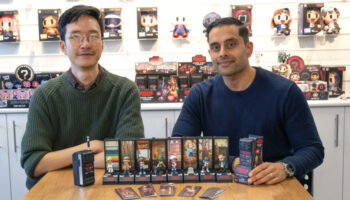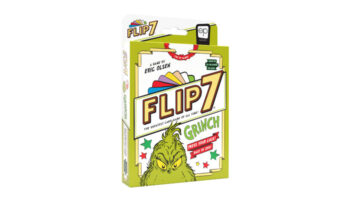John D. Clair on the origins of his real-time horse racing game, Ready Set Bet

John, a huge thanks for doing this. To kick us off, how did you find your way into game design? Was it always on the cards?
I’m not sure if game design was always in the cards for me… Maybe? I certainly gravitated to it at a young age, and I give my parents – especially my mom – a lot of credit for encouraging me to develop my creativity.
I drew a lot of mazes as a kid and started dabbling in game design when I was 7, or maybe younger. At 9 I made up a game called Monster Cards which my friends and I would play, and I describe as “my first not-terrible game design”.
Well, you’ve gone from “not-terrible” to designing some absolute knockout tabletop titles like Mystic Vale, Ecos: New Horizon and Cubitos. What usually kicks off your design process? Where do you find inspiration?
Many places. Often playing games inspires ideas; I’ll find myself really liking a particular aspect of a game and imagining a different design utilising it or something similar in a different context.
For some of my more innovative ideas I’ve used “kinetic design” as an approach to inspiration; the idea of starting with the physicality of an object and from there seeking inspiration and possible game systems.
Interesting. Could you give us an example of that?
Card crafting – a system used in my game Mystic Vale – originated from a kinetic design approach, beginning with the question: “What can a card sleeve physically do?” That resulted in the ah-ha idea that a sleeve could be used to turn multiple cards into a single card.

Yes! And I don’t think I’d ever experienced that kind of physical ‘card crafting’ in a game before Mystic Vale. Great to know where that stemmed from! Now, I’m also interested in theming… At what point does a theme usually present itself to you in the process?
This varies greatly from game to game. Sometimes the theme is part of the inspiration: Ready Set Bet, Ecos, Rolling Heights and Dead Reckoning are in this category. Often the inspiration is around a particular game system, and then I try to imagine themes that would make sense around that core system, like with Mystic Vale and Empire’s End for example.
Occasionally, I have no theme idea and just want to test the game system; in this case Cubitos. And sometimes my theme idea ends up totally different as the publisher takes it in a different direction; this happened with Space Base and Custom Heroes.

You mentioned your new party game Ready Set Bet – I wanted to dive into this one further. I played this for the first time this past week and it’s a winner! Absolutely love it. Where did the seed of the idea come from?
The inspiration for Ready Set Bet really came from a combination of sources. Before I’d ever played or knew about the genre of autobattlers, I really liked the idea of a “game” where a series of exciting 0-player mini-games happened during which players had no control but were invested through decisions made before, during, and/or after the mini-game. Camel Up did this really well and was the most directly influential game on the design of Ready Set Bet.
Several brainstorming emails I’d had with Alex Hauge of CMYK games helped work through broadly related ideas. He had also put out the idea of digital integration for the mini-game, which would be the spark for putting the app-option into Ready Set Bet.
And finally, the crucial seed idea was actually a silly little 0-player game I’d play as a kid, which was as dumb as rolling 2d6 repeatedly and recording the result until a number was rolled 11 times. While rolling I’d have a running commentary in my head like a sports announcer about “break aways”, “come-backs”, “close finishes” and so on.
One day I had 2d6, paper and a pencil on my desk… I just decided to play that game to pass time, and bang! I realised that could be the 0-player mini-game I was looking for!

Amazing! The game has an immediate, visceral excitement that I think is tricky to pull off in a board game. Did it take a lot of playtesting and back-and-forth development-wise to get, or were people up screaming right from the first version?
Actually no, the real-time 2d6 dice rolling race was pretty compelling right out the gate, so I knew very early that I had a winner. Refinement mostly came in the form of getting the betting options to be simple, varied and present difficult choices – plus tweaking the race rules to improve the chances of close races and exciting big moves.
On that, are you a horse-racing fan? Did that steer any part of the process?
Not really. I’ve been to the Santa Anita track here in Los Angeles several times. My first bet I ever placed was a $5, 1-in-100 odds trifecta bet that I lost in a literal photo-finish. But that’s about the extent of my horse racing experience.

Whether you use the app or a friend discovers a skill for horse racing commentary, I’ve found the game works just as well either way. Was there ever a concern in terms of the potential ‘performative’ requirements of the House role?
Absolutely! This was a big topic in development. We didn’t know if the app would come out good enough to replace a good in-person announcer, and we didn’t know if forcing one person to run the race and not play would be a bad experience for more groups than not. In the end the app was good and many groups have discovered that one of their members enjoys being a fun announcer. I’m glad we ended up providing both options.
In terms of other recent launches, you also designed The Last Kingdom board game, based on the Netflix show. Does your design process change much when working on a licensed game?
Yes. My primary objective with any design is to make a fun game. Often, my secondary goal is to do something new with the core of the design that I’ve never seen before in another game. However, with a licensed property, the secondary goal is to make the theme shine through the gameplay, so I’ll be more willing to lean on a tried-and-true game system driving the core game while varying other aspects to make the settings/characters/places of the theme strongly felt.

Last question! What would you say is your most underrated game?
Probably Ecos First Continent. It’s a game with a lot of luck and a lot of strategy. I think for a lot of first-plays, the luck is very apparent but the strategic depth is a bit more obtuse without more plays. This is especially exacerbated since the best way to play the game, in my opinion, is by drafting the starting hands, which is great with experienced players but tough on new players.
Nailing the 1st-play vs 100th-play dichotomy is one of the toughest challenges for me as a designer, and in general, is maybe the most crucial secret-sauce that separates successful great designs from forgotten great designs.

John, a huge thanks for taking time out for this. And congrats again on Ready Set Bet.
–
To stay in the loop with the latest news, interviews and features from the world of toy and game design, sign up to our weekly newsletter here

























